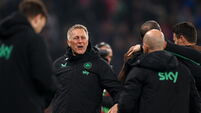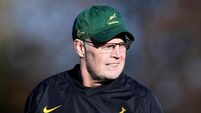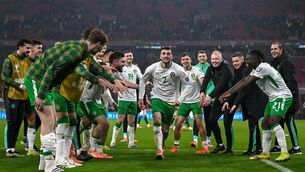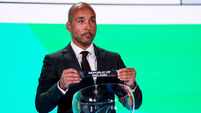Tommy Martin: They dance with different partners but Dublin and Kerry always have eyes for each other
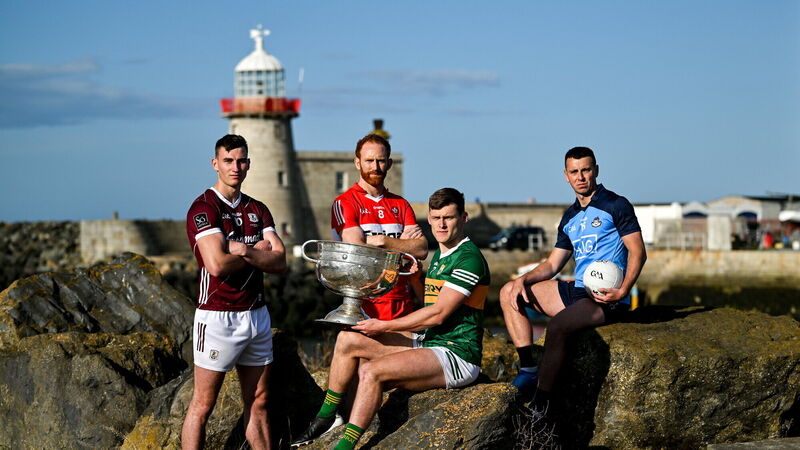
SEMIS TIME: In attendance at the 2023 GAA Football All-Ireland Series national launch are Gavin White of Kerry with the Sam Maguire cup and Cormac Costello of Dublin. Photo by Brendan Moran/Sportsfile
Until All-Ireland quarter-final weekend, making sense of this novel Gaelic football season had been a task fit for the wartime codebreakers of Bletchley Park. Spewing out the raw data since January, this season’s patterns were in turns surprising and familiar; troubling and heartening; conclusive and utterly inconclusive.
The new structure was bad. The games themselves were terrible. The games were terrible because the new structure was bad. There were too many games that didn’t matter. Or maybe every game mattered? If you played every week, you would have momentum. If you played every week, you would be tired. Or maybe both? Sorry, none of this makes sense.
Okay, what about this? Top three in Division One: Mayo, Galway and Roscommon. It would be Connacht’s year. But then it wasn’t. Derry would run aground without their manager, but then they didn’t. Monaghan – too old, too slow – now, two games from their first All-Ireland title. Armagh would cut loose, but then they didn’t. Donegal were burning to the ground, but they staggered from the ashes into the last 12. Cork lost to Clare but beat Mayo. Roscommon beat Mayo and lost to Cork.
Maybe turn it off and turn it back on again?
What we do know, the boffins assured us, is that this would be the most open All-Ireland championship in memory. The data said that much; the numbers didn’t lie. There was no dominant force, no unstoppable juggernauts, no imperial splendour. This was the end of history.
And then, on All-Ireland quarter-final weekend, suddenly we could tell the signal from the noise. Out they came, Dublin and Kerry and tore up the zig-zagging line graphs of the new order and restored Gaelic football’s ancient runes. After all that, just another chapter in the never-ending story. Ban the boffins. Abolish the analysts. We have had enough of experts, quite frankly.
So here they are. They dance with different partners this weekend, but Dublin and Kerry will always have eyes for each other. There is that growing sense, whenever Gaelic football’s star-crossed lovers spot each other across the dancefloor, that the rest of us are merely wallflowers.
If you are from Derry and Monaghan you will feel differently, as you are entitled. It is not every weekend that your county lines up in an All-Ireland semi-final. You will hope your team does not die wondering, like Derry did last year, arm-wrestled out of it by Galway. If you are backing Monaghan you might be a tiny bit glad it is Dublin, and not another suffocating all-Ulster grapple. You will dare to dream. You might tear up the script, shock the world.
But every preview of this weekend’s semi-finals has been an exercise in due diligence: the two Ulster counties being given the courtesy of consideration, like interview candidates for a job long sewn up. Both have been weighed up and praised, and politely sent on their way.
Which would be the case anyway, but there was something about the body language of Gaelic football’s royal rivals a fortnight ago that seemed particularly contemptuous of dreamers, that suggested an end to uncertainties, that sought to underline some home truths.
Neither had done much previously to differentiate themselves from the prevailing turbulence. Dublin had mixed tepid displays with occasional glimpses of trademark ebullience. It was they, remember who allowed Roscommon the notorious six-minute score. At that point, they barely looked arsed. Kerry’s resumé included the usual sleepwalk through Munster, a Killarney paddling by Mayo and a gristly, awkward win over Cork. Hence the murky picture.
But then the fog of war lifted, revealing green and gold, sky blue and navy, yet again. Kerry’s performance against Tyrone was, of course, a direct riposte to what happened in the semi-final two years ago. But more than that, it was a restating of fundamentals, as if a dusty old copy of Dick Fitzgerald’s century-old tome had been passed around the dressing room beforehand.
It was built on basics. Backs got out in front of their men and won the ball. The ball was delivered quickly to forwards who either turned for goal themselves or laid it off to supporting runners. Possession was only retained as a brief precursor to a lacerating kick pass. And, as we were reminded by David Clifford’s sideline sleight of hand and Diarmuid O’Connor’s dummy sashay before taking his goal, there is always room for magic in the old game.
Case study: O’Connor’s point on the half-hour mark. The Kerry midfielder pops the ball off to Jason Foley, stalking menacingly, his head up, scanning the horizon. Suddenly Foley spots his prey and delivers a perfectly weighted kick pass that sits up in front of the onrushing Seán O’Shea with a ribbon and a name tag on it. O’Shea has no sooner grabbed it than O’Connor appears to his left, accepting the layoff and embarking on a short slalom through Tyrone cover before leaning to his left to caress the ball over the bar. Hang it in the Louvre, as they say.
A day later, Dublin burned off Mayo in a game in which both sides seemed similarly sworn to the old ways. Man on man, long kicks into the square, searing runners burning up the Croke Park turf. When Mayo faded Dublin took on a timeless look: you could squint your eyes and see Kevin Moran bursting from deep in the runs of James McCarthy; Jimmy Keaveney’s economical mischief was alive in their forwards’ scoretaking; and when Colm Basquel rippled the net in front of a sun-dappled Hill, Jayo was reborn.
So, then: have Dublin and Kerry come to save Gaelic football? Is that the reassuring message from this complicated, strange season, with its modernist structures and acres of unwatchable dross?
The boffins might say it is too early to tell; that the data is, as yet, inconclusive. But Gaelic football’s power couple have given us a glimpse of the game’s battered soul. And, in a year when putting games behind a paywall was often an act of mercy, it will be impossible to take your eyes off what happens next.






